ACC101 Accounting for Decision Making: Applicator Case Study Analysis
VerifiedAdded on 2023/01/17
|12
|2773
|96
Case Study
AI Summary
This case study analyzes the financial performance of Applicator, an AI service provider, using financial statements from 2014 to 2018. It employs horizontal, vertical, ratio, and trend analysis to assess the company's profitability, efficiency, capital structure, and liquidity. The analysis reveals trends in sales, cost of goods sold, and net profits, highlighting both positive aspects like increasing sales and areas of concern such as declining owner's equity and increasing liabilities. The study calculates and interprets key ratios including net profit ratio, gross profit ratio, return on equity and assets, asset turnover, current ratio, and debt-to-equity ratio to provide a comprehensive overview of Applicator's financial health. Recommendations are provided to address challenges and leverage opportunities for future growth and financial stability, suggesting areas for improvement and strategic decision-making for the company's management.
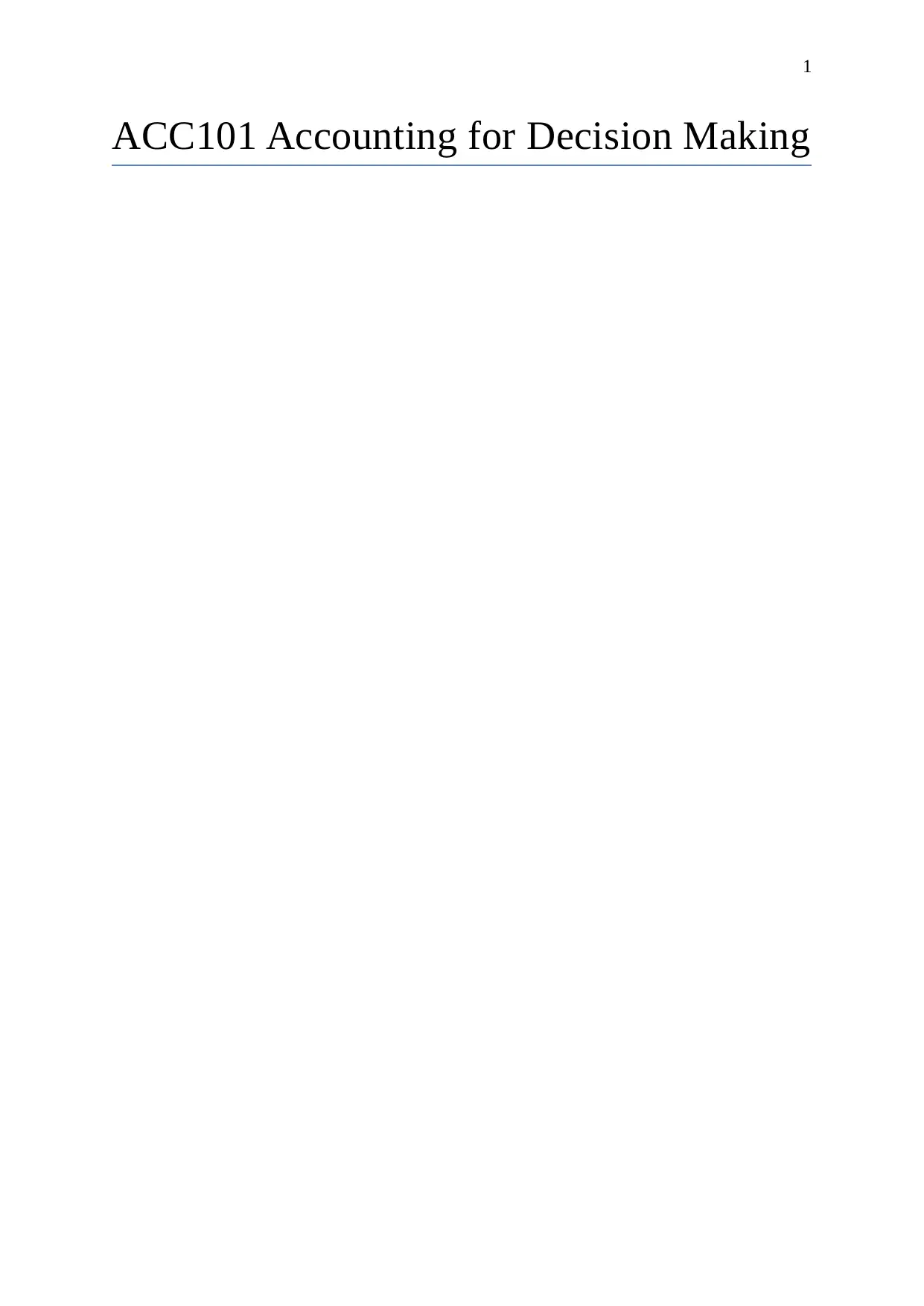
1
ACC101 Accounting for Decision Making
ACC101 Accounting for Decision Making
Paraphrase This Document
Need a fresh take? Get an instant paraphrase of this document with our AI Paraphraser
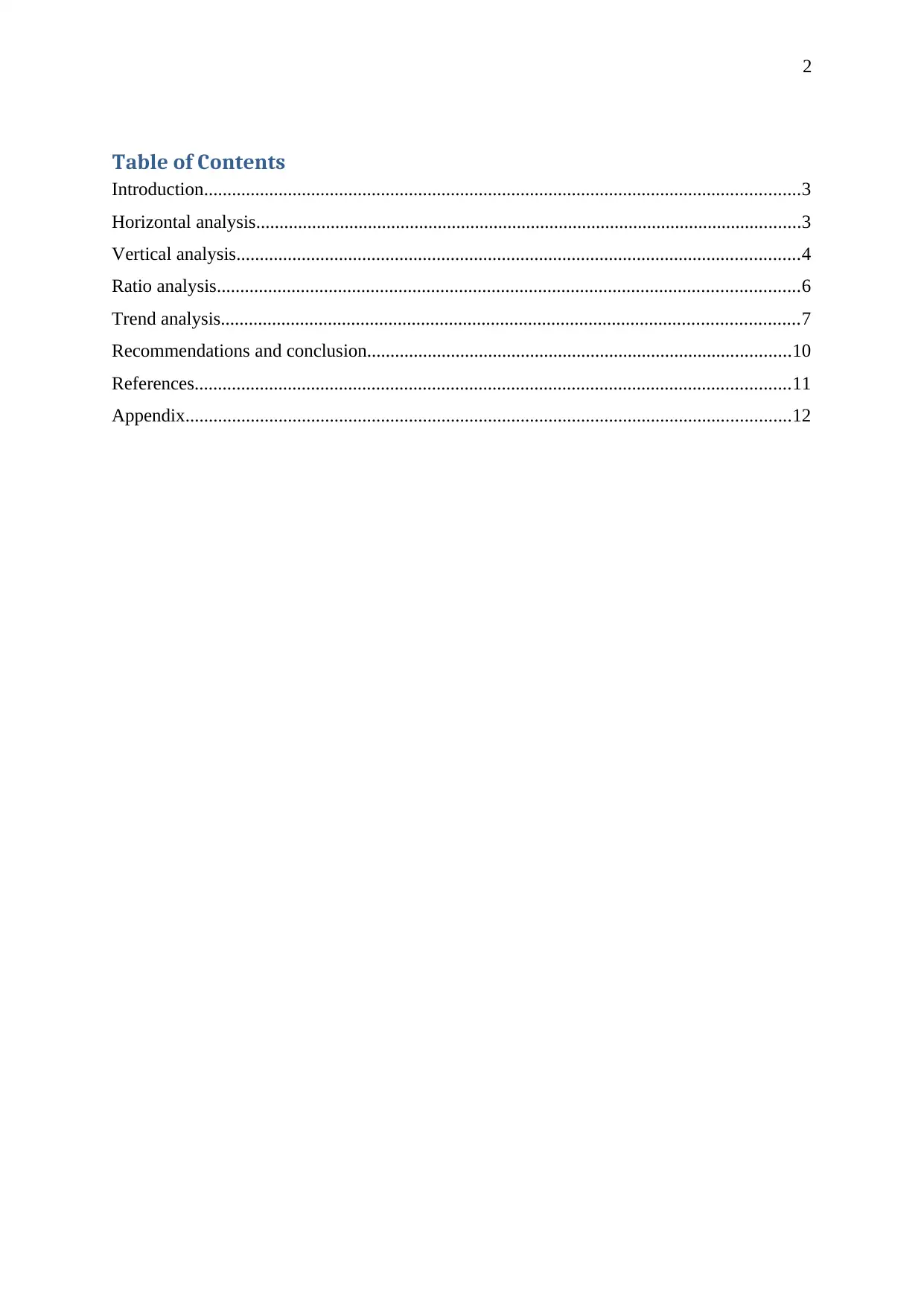
2
Table of Contents
Introduction................................................................................................................................3
Horizontal analysis.....................................................................................................................3
Vertical analysis.........................................................................................................................4
Ratio analysis.............................................................................................................................6
Trend analysis............................................................................................................................7
Recommendations and conclusion...........................................................................................10
References................................................................................................................................11
Appendix..................................................................................................................................12
Table of Contents
Introduction................................................................................................................................3
Horizontal analysis.....................................................................................................................3
Vertical analysis.........................................................................................................................4
Ratio analysis.............................................................................................................................6
Trend analysis............................................................................................................................7
Recommendations and conclusion...........................................................................................10
References................................................................................................................................11
Appendix..................................................................................................................................12
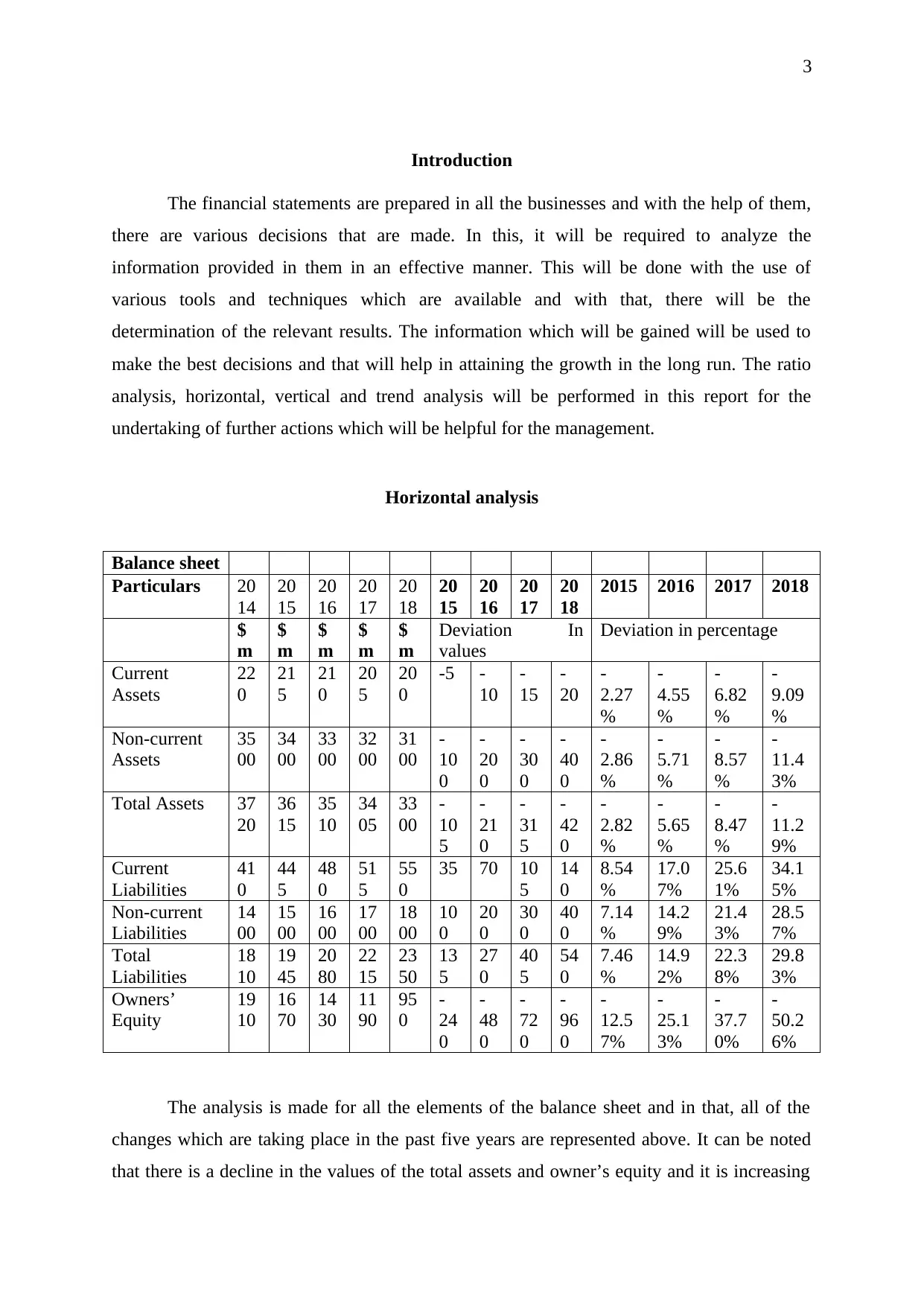
3
Introduction
The financial statements are prepared in all the businesses and with the help of them,
there are various decisions that are made. In this, it will be required to analyze the
information provided in them in an effective manner. This will be done with the use of
various tools and techniques which are available and with that, there will be the
determination of the relevant results. The information which will be gained will be used to
make the best decisions and that will help in attaining the growth in the long run. The ratio
analysis, horizontal, vertical and trend analysis will be performed in this report for the
undertaking of further actions which will be helpful for the management.
Horizontal analysis
Balance sheet
Particulars 20
14
20
15
20
16
20
17
20
18
20
15
20
16
20
17
20
18
2015 2016 2017 2018
$
m
$
m
$
m
$
m
$
m
Deviation In
values
Deviation in percentage
Current
Assets
22
0
21
5
21
0
20
5
20
0
-5 -
10
-
15
-
20
-
2.27
%
-
4.55
%
-
6.82
%
-
9.09
%
Non-current
Assets
35
00
34
00
33
00
32
00
31
00
-
10
0
-
20
0
-
30
0
-
40
0
-
2.86
%
-
5.71
%
-
8.57
%
-
11.4
3%
Total Assets 37
20
36
15
35
10
34
05
33
00
-
10
5
-
21
0
-
31
5
-
42
0
-
2.82
%
-
5.65
%
-
8.47
%
-
11.2
9%
Current
Liabilities
41
0
44
5
48
0
51
5
55
0
35 70 10
5
14
0
8.54
%
17.0
7%
25.6
1%
34.1
5%
Non-current
Liabilities
14
00
15
00
16
00
17
00
18
00
10
0
20
0
30
0
40
0
7.14
%
14.2
9%
21.4
3%
28.5
7%
Total
Liabilities
18
10
19
45
20
80
22
15
23
50
13
5
27
0
40
5
54
0
7.46
%
14.9
2%
22.3
8%
29.8
3%
Owners’
Equity
19
10
16
70
14
30
11
90
95
0
-
24
0
-
48
0
-
72
0
-
96
0
-
12.5
7%
-
25.1
3%
-
37.7
0%
-
50.2
6%
The analysis is made for all the elements of the balance sheet and in that, all of the
changes which are taking place in the past five years are represented above. It can be noted
that there is a decline in the values of the total assets and owner’s equity and it is increasing
Introduction
The financial statements are prepared in all the businesses and with the help of them,
there are various decisions that are made. In this, it will be required to analyze the
information provided in them in an effective manner. This will be done with the use of
various tools and techniques which are available and with that, there will be the
determination of the relevant results. The information which will be gained will be used to
make the best decisions and that will help in attaining the growth in the long run. The ratio
analysis, horizontal, vertical and trend analysis will be performed in this report for the
undertaking of further actions which will be helpful for the management.
Horizontal analysis
Balance sheet
Particulars 20
14
20
15
20
16
20
17
20
18
20
15
20
16
20
17
20
18
2015 2016 2017 2018
$
m
$
m
$
m
$
m
$
m
Deviation In
values
Deviation in percentage
Current
Assets
22
0
21
5
21
0
20
5
20
0
-5 -
10
-
15
-
20
-
2.27
%
-
4.55
%
-
6.82
%
-
9.09
%
Non-current
Assets
35
00
34
00
33
00
32
00
31
00
-
10
0
-
20
0
-
30
0
-
40
0
-
2.86
%
-
5.71
%
-
8.57
%
-
11.4
3%
Total Assets 37
20
36
15
35
10
34
05
33
00
-
10
5
-
21
0
-
31
5
-
42
0
-
2.82
%
-
5.65
%
-
8.47
%
-
11.2
9%
Current
Liabilities
41
0
44
5
48
0
51
5
55
0
35 70 10
5
14
0
8.54
%
17.0
7%
25.6
1%
34.1
5%
Non-current
Liabilities
14
00
15
00
16
00
17
00
18
00
10
0
20
0
30
0
40
0
7.14
%
14.2
9%
21.4
3%
28.5
7%
Total
Liabilities
18
10
19
45
20
80
22
15
23
50
13
5
27
0
40
5
54
0
7.46
%
14.9
2%
22.3
8%
29.8
3%
Owners’
Equity
19
10
16
70
14
30
11
90
95
0
-
24
0
-
48
0
-
72
0
-
96
0
-
12.5
7%
-
25.1
3%
-
37.7
0%
-
50.2
6%
The analysis is made for all the elements of the balance sheet and in that, all of the
changes which are taking place in the past five years are represented above. It can be noted
that there is a decline in the values of the total assets and owner’s equity and it is increasing
⊘ This is a preview!⊘
Do you want full access?
Subscribe today to unlock all pages.

Trusted by 1+ million students worldwide
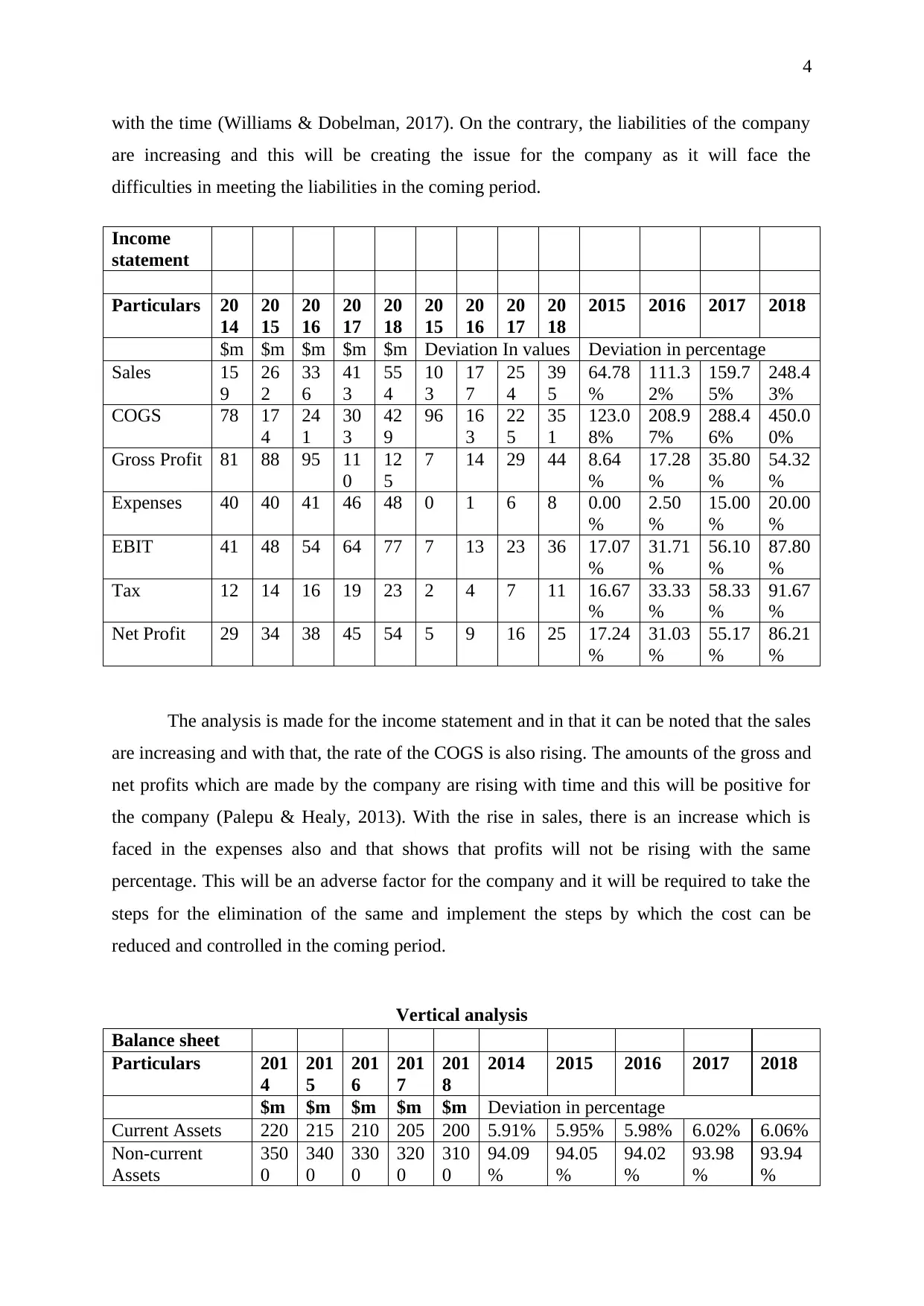
4
with the time (Williams & Dobelman, 2017). On the contrary, the liabilities of the company
are increasing and this will be creating the issue for the company as it will face the
difficulties in meeting the liabilities in the coming period.
Income
statement
Particulars 20
14
20
15
20
16
20
17
20
18
20
15
20
16
20
17
20
18
2015 2016 2017 2018
$m $m $m $m $m Deviation In values Deviation in percentage
Sales 15
9
26
2
33
6
41
3
55
4
10
3
17
7
25
4
39
5
64.78
%
111.3
2%
159.7
5%
248.4
3%
COGS 78 17
4
24
1
30
3
42
9
96 16
3
22
5
35
1
123.0
8%
208.9
7%
288.4
6%
450.0
0%
Gross Profit 81 88 95 11
0
12
5
7 14 29 44 8.64
%
17.28
%
35.80
%
54.32
%
Expenses 40 40 41 46 48 0 1 6 8 0.00
%
2.50
%
15.00
%
20.00
%
EBIT 41 48 54 64 77 7 13 23 36 17.07
%
31.71
%
56.10
%
87.80
%
Tax 12 14 16 19 23 2 4 7 11 16.67
%
33.33
%
58.33
%
91.67
%
Net Profit 29 34 38 45 54 5 9 16 25 17.24
%
31.03
%
55.17
%
86.21
%
The analysis is made for the income statement and in that it can be noted that the sales
are increasing and with that, the rate of the COGS is also rising. The amounts of the gross and
net profits which are made by the company are rising with time and this will be positive for
the company (Palepu & Healy, 2013). With the rise in sales, there is an increase which is
faced in the expenses also and that shows that profits will not be rising with the same
percentage. This will be an adverse factor for the company and it will be required to take the
steps for the elimination of the same and implement the steps by which the cost can be
reduced and controlled in the coming period.
Vertical analysis
Balance sheet
Particulars 201
4
201
5
201
6
201
7
201
8
2014 2015 2016 2017 2018
$m $m $m $m $m Deviation in percentage
Current Assets 220 215 210 205 200 5.91% 5.95% 5.98% 6.02% 6.06%
Non-current
Assets
350
0
340
0
330
0
320
0
310
0
94.09
%
94.05
%
94.02
%
93.98
%
93.94
%
with the time (Williams & Dobelman, 2017). On the contrary, the liabilities of the company
are increasing and this will be creating the issue for the company as it will face the
difficulties in meeting the liabilities in the coming period.
Income
statement
Particulars 20
14
20
15
20
16
20
17
20
18
20
15
20
16
20
17
20
18
2015 2016 2017 2018
$m $m $m $m $m Deviation In values Deviation in percentage
Sales 15
9
26
2
33
6
41
3
55
4
10
3
17
7
25
4
39
5
64.78
%
111.3
2%
159.7
5%
248.4
3%
COGS 78 17
4
24
1
30
3
42
9
96 16
3
22
5
35
1
123.0
8%
208.9
7%
288.4
6%
450.0
0%
Gross Profit 81 88 95 11
0
12
5
7 14 29 44 8.64
%
17.28
%
35.80
%
54.32
%
Expenses 40 40 41 46 48 0 1 6 8 0.00
%
2.50
%
15.00
%
20.00
%
EBIT 41 48 54 64 77 7 13 23 36 17.07
%
31.71
%
56.10
%
87.80
%
Tax 12 14 16 19 23 2 4 7 11 16.67
%
33.33
%
58.33
%
91.67
%
Net Profit 29 34 38 45 54 5 9 16 25 17.24
%
31.03
%
55.17
%
86.21
%
The analysis is made for the income statement and in that it can be noted that the sales
are increasing and with that, the rate of the COGS is also rising. The amounts of the gross and
net profits which are made by the company are rising with time and this will be positive for
the company (Palepu & Healy, 2013). With the rise in sales, there is an increase which is
faced in the expenses also and that shows that profits will not be rising with the same
percentage. This will be an adverse factor for the company and it will be required to take the
steps for the elimination of the same and implement the steps by which the cost can be
reduced and controlled in the coming period.
Vertical analysis
Balance sheet
Particulars 201
4
201
5
201
6
201
7
201
8
2014 2015 2016 2017 2018
$m $m $m $m $m Deviation in percentage
Current Assets 220 215 210 205 200 5.91% 5.95% 5.98% 6.02% 6.06%
Non-current
Assets
350
0
340
0
330
0
320
0
310
0
94.09
%
94.05
%
94.02
%
93.98
%
93.94
%
Paraphrase This Document
Need a fresh take? Get an instant paraphrase of this document with our AI Paraphraser
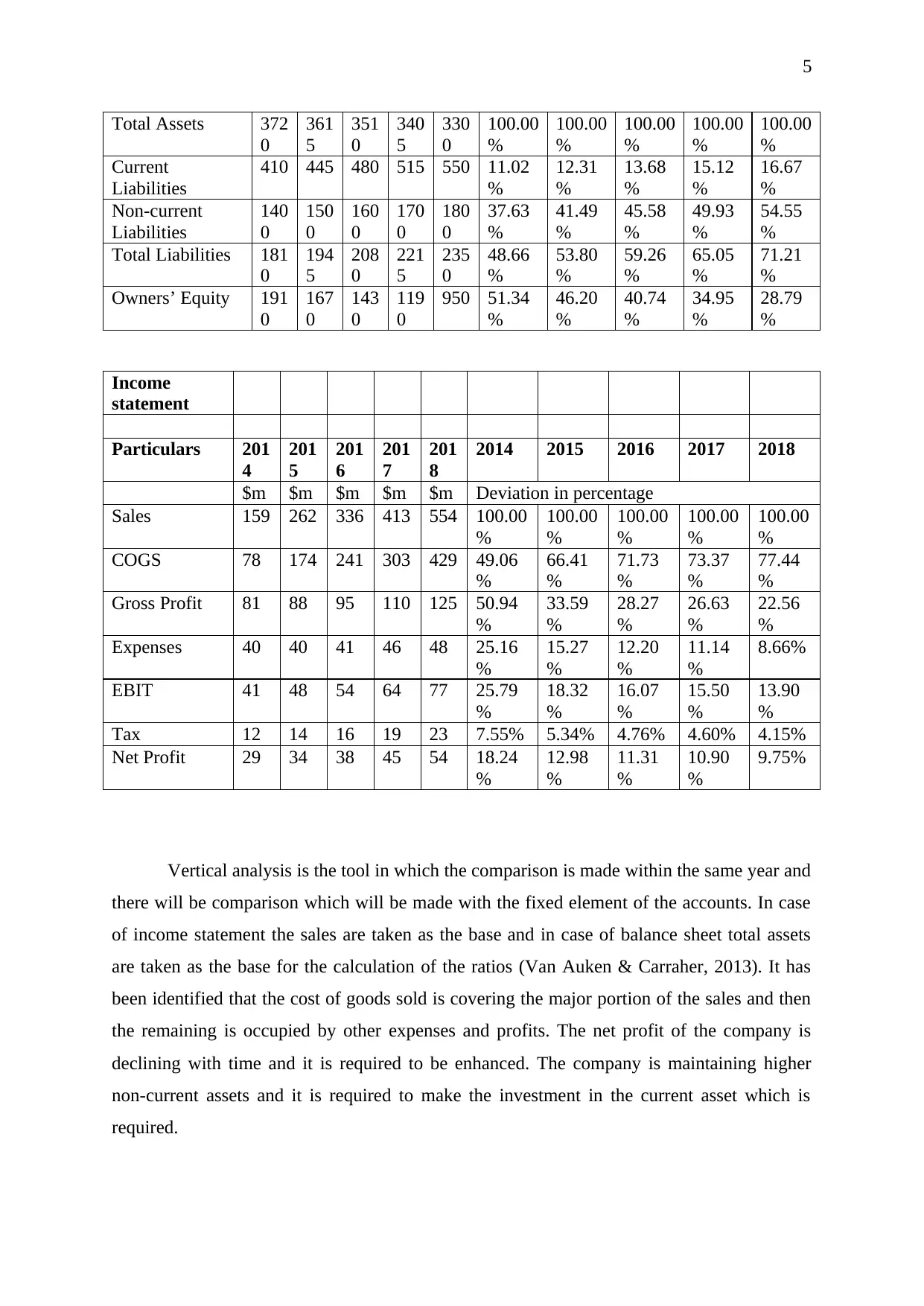
5
Total Assets 372
0
361
5
351
0
340
5
330
0
100.00
%
100.00
%
100.00
%
100.00
%
100.00
%
Current
Liabilities
410 445 480 515 550 11.02
%
12.31
%
13.68
%
15.12
%
16.67
%
Non-current
Liabilities
140
0
150
0
160
0
170
0
180
0
37.63
%
41.49
%
45.58
%
49.93
%
54.55
%
Total Liabilities 181
0
194
5
208
0
221
5
235
0
48.66
%
53.80
%
59.26
%
65.05
%
71.21
%
Owners’ Equity 191
0
167
0
143
0
119
0
950 51.34
%
46.20
%
40.74
%
34.95
%
28.79
%
Income
statement
Particulars 201
4
201
5
201
6
201
7
201
8
2014 2015 2016 2017 2018
$m $m $m $m $m Deviation in percentage
Sales 159 262 336 413 554 100.00
%
100.00
%
100.00
%
100.00
%
100.00
%
COGS 78 174 241 303 429 49.06
%
66.41
%
71.73
%
73.37
%
77.44
%
Gross Profit 81 88 95 110 125 50.94
%
33.59
%
28.27
%
26.63
%
22.56
%
Expenses 40 40 41 46 48 25.16
%
15.27
%
12.20
%
11.14
%
8.66%
EBIT 41 48 54 64 77 25.79
%
18.32
%
16.07
%
15.50
%
13.90
%
Tax 12 14 16 19 23 7.55% 5.34% 4.76% 4.60% 4.15%
Net Profit 29 34 38 45 54 18.24
%
12.98
%
11.31
%
10.90
%
9.75%
Vertical analysis is the tool in which the comparison is made within the same year and
there will be comparison which will be made with the fixed element of the accounts. In case
of income statement the sales are taken as the base and in case of balance sheet total assets
are taken as the base for the calculation of the ratios (Van Auken & Carraher, 2013). It has
been identified that the cost of goods sold is covering the major portion of the sales and then
the remaining is occupied by other expenses and profits. The net profit of the company is
declining with time and it is required to be enhanced. The company is maintaining higher
non-current assets and it is required to make the investment in the current asset which is
required.
Total Assets 372
0
361
5
351
0
340
5
330
0
100.00
%
100.00
%
100.00
%
100.00
%
100.00
%
Current
Liabilities
410 445 480 515 550 11.02
%
12.31
%
13.68
%
15.12
%
16.67
%
Non-current
Liabilities
140
0
150
0
160
0
170
0
180
0
37.63
%
41.49
%
45.58
%
49.93
%
54.55
%
Total Liabilities 181
0
194
5
208
0
221
5
235
0
48.66
%
53.80
%
59.26
%
65.05
%
71.21
%
Owners’ Equity 191
0
167
0
143
0
119
0
950 51.34
%
46.20
%
40.74
%
34.95
%
28.79
%
Income
statement
Particulars 201
4
201
5
201
6
201
7
201
8
2014 2015 2016 2017 2018
$m $m $m $m $m Deviation in percentage
Sales 159 262 336 413 554 100.00
%
100.00
%
100.00
%
100.00
%
100.00
%
COGS 78 174 241 303 429 49.06
%
66.41
%
71.73
%
73.37
%
77.44
%
Gross Profit 81 88 95 110 125 50.94
%
33.59
%
28.27
%
26.63
%
22.56
%
Expenses 40 40 41 46 48 25.16
%
15.27
%
12.20
%
11.14
%
8.66%
EBIT 41 48 54 64 77 25.79
%
18.32
%
16.07
%
15.50
%
13.90
%
Tax 12 14 16 19 23 7.55% 5.34% 4.76% 4.60% 4.15%
Net Profit 29 34 38 45 54 18.24
%
12.98
%
11.31
%
10.90
%
9.75%
Vertical analysis is the tool in which the comparison is made within the same year and
there will be comparison which will be made with the fixed element of the accounts. In case
of income statement the sales are taken as the base and in case of balance sheet total assets
are taken as the base for the calculation of the ratios (Van Auken & Carraher, 2013). It has
been identified that the cost of goods sold is covering the major portion of the sales and then
the remaining is occupied by other expenses and profits. The net profit of the company is
declining with time and it is required to be enhanced. The company is maintaining higher
non-current assets and it is required to make the investment in the current asset which is
required.
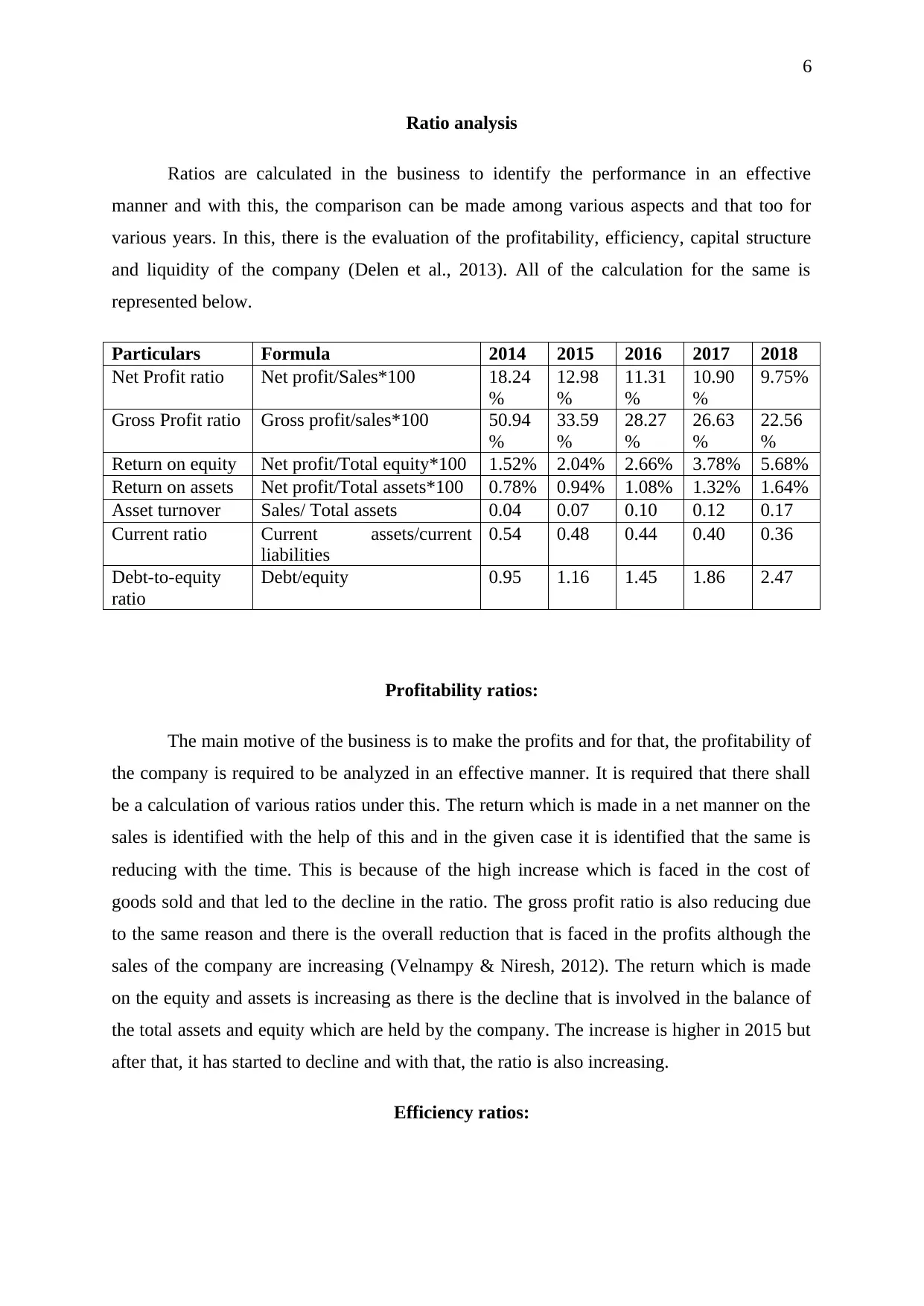
6
Ratio analysis
Ratios are calculated in the business to identify the performance in an effective
manner and with this, the comparison can be made among various aspects and that too for
various years. In this, there is the evaluation of the profitability, efficiency, capital structure
and liquidity of the company (Delen et al., 2013). All of the calculation for the same is
represented below.
Particulars Formula 2014 2015 2016 2017 2018
Net Profit ratio Net profit/Sales*100 18.24
%
12.98
%
11.31
%
10.90
%
9.75%
Gross Profit ratio Gross profit/sales*100 50.94
%
33.59
%
28.27
%
26.63
%
22.56
%
Return on equity Net profit/Total equity*100 1.52% 2.04% 2.66% 3.78% 5.68%
Return on assets Net profit/Total assets*100 0.78% 0.94% 1.08% 1.32% 1.64%
Asset turnover Sales/ Total assets 0.04 0.07 0.10 0.12 0.17
Current ratio Current assets/current
liabilities
0.54 0.48 0.44 0.40 0.36
Debt-to-equity
ratio
Debt/equity 0.95 1.16 1.45 1.86 2.47
Profitability ratios:
The main motive of the business is to make the profits and for that, the profitability of
the company is required to be analyzed in an effective manner. It is required that there shall
be a calculation of various ratios under this. The return which is made in a net manner on the
sales is identified with the help of this and in the given case it is identified that the same is
reducing with the time. This is because of the high increase which is faced in the cost of
goods sold and that led to the decline in the ratio. The gross profit ratio is also reducing due
to the same reason and there is the overall reduction that is faced in the profits although the
sales of the company are increasing (Velnampy & Niresh, 2012). The return which is made
on the equity and assets is increasing as there is the decline that is involved in the balance of
the total assets and equity which are held by the company. The increase is higher in 2015 but
after that, it has started to decline and with that, the ratio is also increasing.
Efficiency ratios:
Ratio analysis
Ratios are calculated in the business to identify the performance in an effective
manner and with this, the comparison can be made among various aspects and that too for
various years. In this, there is the evaluation of the profitability, efficiency, capital structure
and liquidity of the company (Delen et al., 2013). All of the calculation for the same is
represented below.
Particulars Formula 2014 2015 2016 2017 2018
Net Profit ratio Net profit/Sales*100 18.24
%
12.98
%
11.31
%
10.90
%
9.75%
Gross Profit ratio Gross profit/sales*100 50.94
%
33.59
%
28.27
%
26.63
%
22.56
%
Return on equity Net profit/Total equity*100 1.52% 2.04% 2.66% 3.78% 5.68%
Return on assets Net profit/Total assets*100 0.78% 0.94% 1.08% 1.32% 1.64%
Asset turnover Sales/ Total assets 0.04 0.07 0.10 0.12 0.17
Current ratio Current assets/current
liabilities
0.54 0.48 0.44 0.40 0.36
Debt-to-equity
ratio
Debt/equity 0.95 1.16 1.45 1.86 2.47
Profitability ratios:
The main motive of the business is to make the profits and for that, the profitability of
the company is required to be analyzed in an effective manner. It is required that there shall
be a calculation of various ratios under this. The return which is made in a net manner on the
sales is identified with the help of this and in the given case it is identified that the same is
reducing with the time. This is because of the high increase which is faced in the cost of
goods sold and that led to the decline in the ratio. The gross profit ratio is also reducing due
to the same reason and there is the overall reduction that is faced in the profits although the
sales of the company are increasing (Velnampy & Niresh, 2012). The return which is made
on the equity and assets is increasing as there is the decline that is involved in the balance of
the total assets and equity which are held by the company. The increase is higher in 2015 but
after that, it has started to decline and with that, the ratio is also increasing.
Efficiency ratios:
⊘ This is a preview!⊘
Do you want full access?
Subscribe today to unlock all pages.

Trusted by 1+ million students worldwide
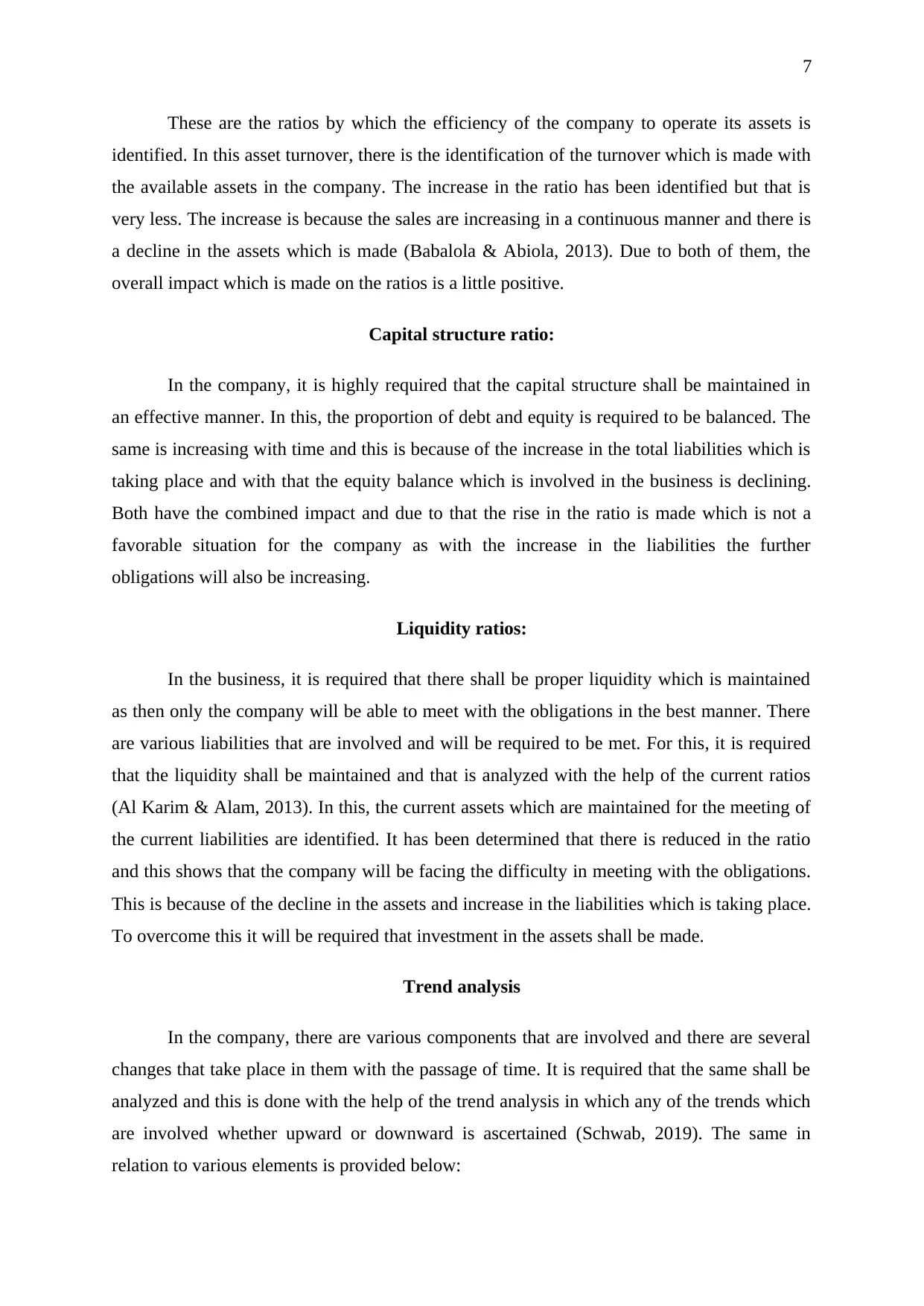
7
These are the ratios by which the efficiency of the company to operate its assets is
identified. In this asset turnover, there is the identification of the turnover which is made with
the available assets in the company. The increase in the ratio has been identified but that is
very less. The increase is because the sales are increasing in a continuous manner and there is
a decline in the assets which is made (Babalola & Abiola, 2013). Due to both of them, the
overall impact which is made on the ratios is a little positive.
Capital structure ratio:
In the company, it is highly required that the capital structure shall be maintained in
an effective manner. In this, the proportion of debt and equity is required to be balanced. The
same is increasing with time and this is because of the increase in the total liabilities which is
taking place and with that the equity balance which is involved in the business is declining.
Both have the combined impact and due to that the rise in the ratio is made which is not a
favorable situation for the company as with the increase in the liabilities the further
obligations will also be increasing.
Liquidity ratios:
In the business, it is required that there shall be proper liquidity which is maintained
as then only the company will be able to meet with the obligations in the best manner. There
are various liabilities that are involved and will be required to be met. For this, it is required
that the liquidity shall be maintained and that is analyzed with the help of the current ratios
(Al Karim & Alam, 2013). In this, the current assets which are maintained for the meeting of
the current liabilities are identified. It has been determined that there is reduced in the ratio
and this shows that the company will be facing the difficulty in meeting with the obligations.
This is because of the decline in the assets and increase in the liabilities which is taking place.
To overcome this it will be required that investment in the assets shall be made.
Trend analysis
In the company, there are various components that are involved and there are several
changes that take place in them with the passage of time. It is required that the same shall be
analyzed and this is done with the help of the trend analysis in which any of the trends which
are involved whether upward or downward is ascertained (Schwab, 2019). The same in
relation to various elements is provided below:
These are the ratios by which the efficiency of the company to operate its assets is
identified. In this asset turnover, there is the identification of the turnover which is made with
the available assets in the company. The increase in the ratio has been identified but that is
very less. The increase is because the sales are increasing in a continuous manner and there is
a decline in the assets which is made (Babalola & Abiola, 2013). Due to both of them, the
overall impact which is made on the ratios is a little positive.
Capital structure ratio:
In the company, it is highly required that the capital structure shall be maintained in
an effective manner. In this, the proportion of debt and equity is required to be balanced. The
same is increasing with time and this is because of the increase in the total liabilities which is
taking place and with that the equity balance which is involved in the business is declining.
Both have the combined impact and due to that the rise in the ratio is made which is not a
favorable situation for the company as with the increase in the liabilities the further
obligations will also be increasing.
Liquidity ratios:
In the business, it is required that there shall be proper liquidity which is maintained
as then only the company will be able to meet with the obligations in the best manner. There
are various liabilities that are involved and will be required to be met. For this, it is required
that the liquidity shall be maintained and that is analyzed with the help of the current ratios
(Al Karim & Alam, 2013). In this, the current assets which are maintained for the meeting of
the current liabilities are identified. It has been determined that there is reduced in the ratio
and this shows that the company will be facing the difficulty in meeting with the obligations.
This is because of the decline in the assets and increase in the liabilities which is taking place.
To overcome this it will be required that investment in the assets shall be made.
Trend analysis
In the company, there are various components that are involved and there are several
changes that take place in them with the passage of time. It is required that the same shall be
analyzed and this is done with the help of the trend analysis in which any of the trends which
are involved whether upward or downward is ascertained (Schwab, 2019). The same in
relation to various elements is provided below:
Paraphrase This Document
Need a fresh take? Get an instant paraphrase of this document with our AI Paraphraser
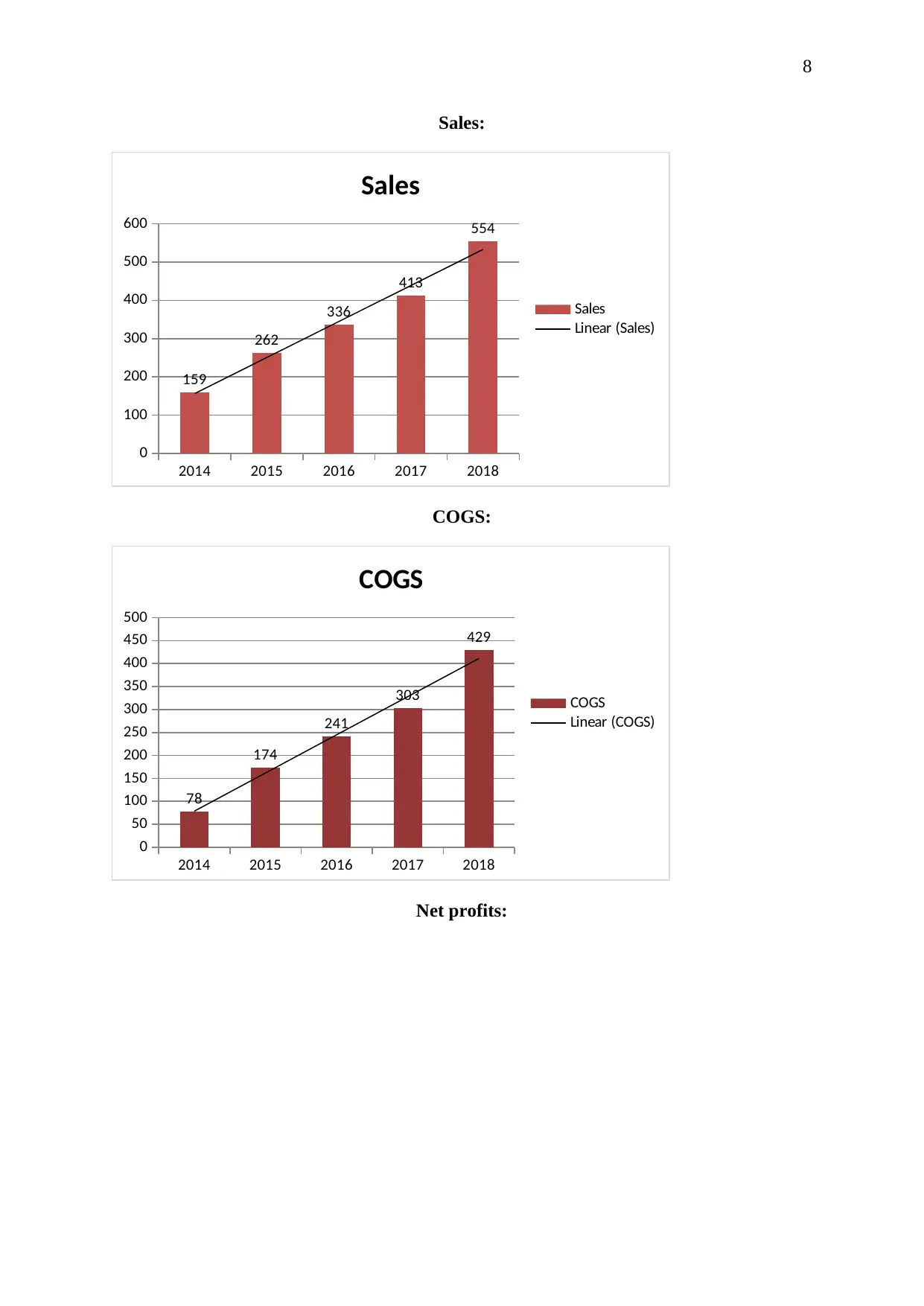
8
Sales:
2014 2015 2016 2017 2018
0
100
200
300
400
500
600
159
262
336
413
554
Sales
Sales
Linear (Sales)
COGS:
2014 2015 2016 2017 2018
0
50
100
150
200
250
300
350
400
450
500
78
174
241
303
429
COGS
COGS
Linear (COGS)
Net profits:
Sales:
2014 2015 2016 2017 2018
0
100
200
300
400
500
600
159
262
336
413
554
Sales
Sales
Linear (Sales)
COGS:
2014 2015 2016 2017 2018
0
50
100
150
200
250
300
350
400
450
500
78
174
241
303
429
COGS
COGS
Linear (COGS)
Net profits:
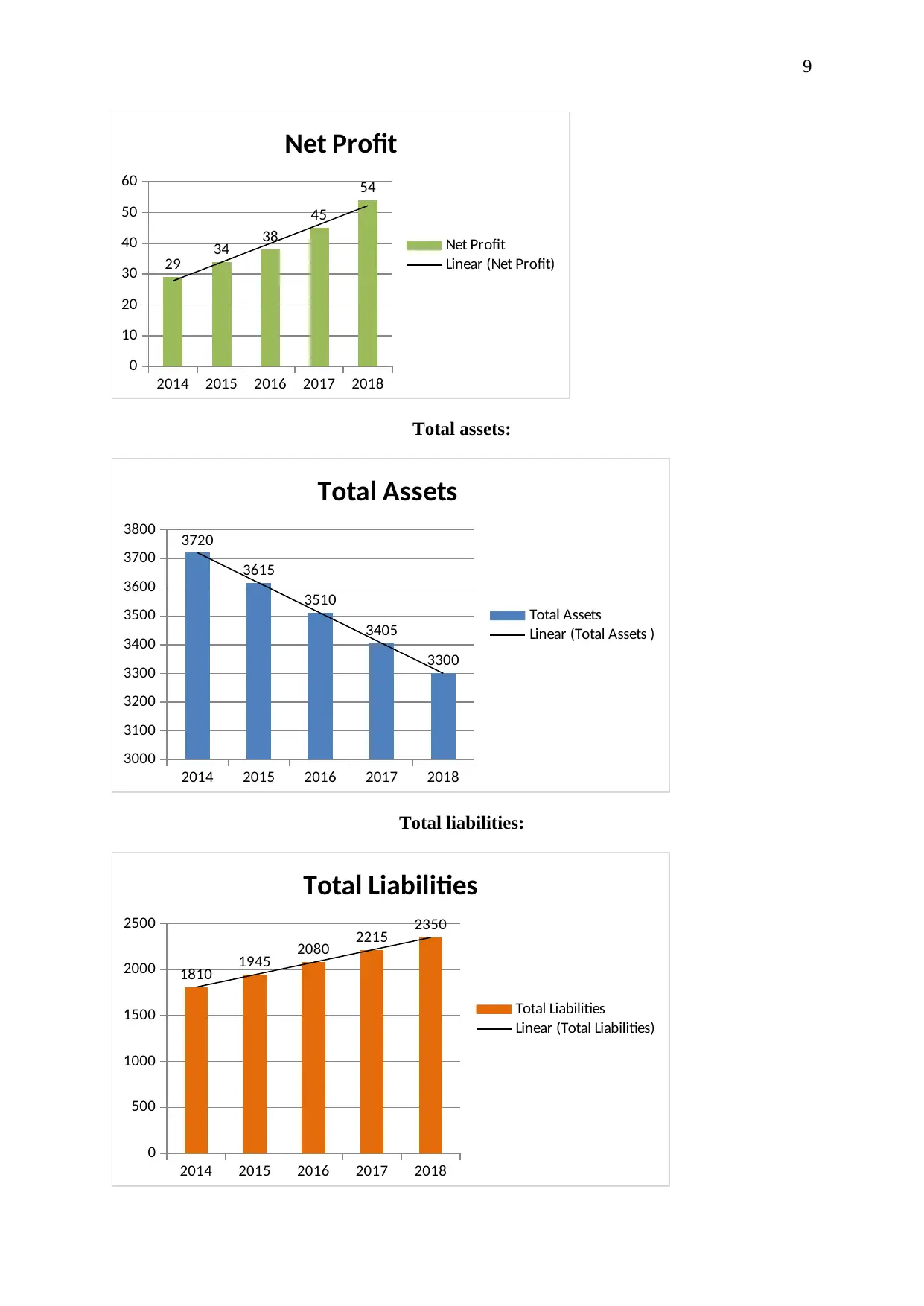
9
2014 2015 2016 2017 2018
0
10
20
30
40
50
60
29 34 38
45
54
Net Profit
Net Profit
Linear (Net Profit)
Total assets:
2014 2015 2016 2017 2018
3000
3100
3200
3300
3400
3500
3600
3700
3800 3720
3615
3510
3405
3300
Total Assets
Total Assets
Linear (Total Assets )
Total liabilities:
2014 2015 2016 2017 2018
0
500
1000
1500
2000
2500
1810 1945 2080 2215 2350
Total Liabilities
Total Liabilities
Linear (Total Liabilities)
2014 2015 2016 2017 2018
0
10
20
30
40
50
60
29 34 38
45
54
Net Profit
Net Profit
Linear (Net Profit)
Total assets:
2014 2015 2016 2017 2018
3000
3100
3200
3300
3400
3500
3600
3700
3800 3720
3615
3510
3405
3300
Total Assets
Total Assets
Linear (Total Assets )
Total liabilities:
2014 2015 2016 2017 2018
0
500
1000
1500
2000
2500
1810 1945 2080 2215 2350
Total Liabilities
Total Liabilities
Linear (Total Liabilities)
⊘ This is a preview!⊘
Do you want full access?
Subscribe today to unlock all pages.

Trusted by 1+ million students worldwide
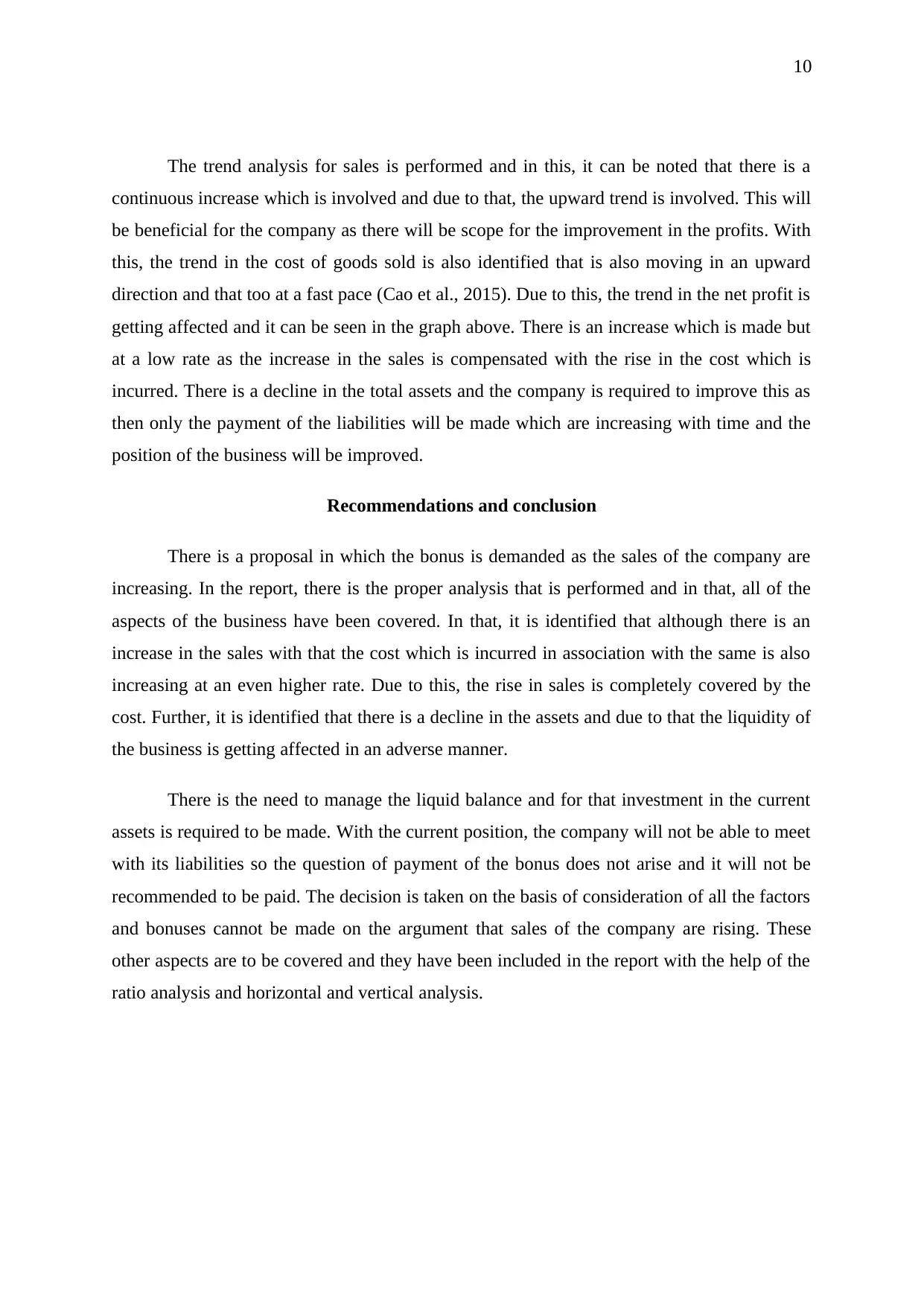
10
The trend analysis for sales is performed and in this, it can be noted that there is a
continuous increase which is involved and due to that, the upward trend is involved. This will
be beneficial for the company as there will be scope for the improvement in the profits. With
this, the trend in the cost of goods sold is also identified that is also moving in an upward
direction and that too at a fast pace (Cao et al., 2015). Due to this, the trend in the net profit is
getting affected and it can be seen in the graph above. There is an increase which is made but
at a low rate as the increase in the sales is compensated with the rise in the cost which is
incurred. There is a decline in the total assets and the company is required to improve this as
then only the payment of the liabilities will be made which are increasing with time and the
position of the business will be improved.
Recommendations and conclusion
There is a proposal in which the bonus is demanded as the sales of the company are
increasing. In the report, there is the proper analysis that is performed and in that, all of the
aspects of the business have been covered. In that, it is identified that although there is an
increase in the sales with that the cost which is incurred in association with the same is also
increasing at an even higher rate. Due to this, the rise in sales is completely covered by the
cost. Further, it is identified that there is a decline in the assets and due to that the liquidity of
the business is getting affected in an adverse manner.
There is the need to manage the liquid balance and for that investment in the current
assets is required to be made. With the current position, the company will not be able to meet
with its liabilities so the question of payment of the bonus does not arise and it will not be
recommended to be paid. The decision is taken on the basis of consideration of all the factors
and bonuses cannot be made on the argument that sales of the company are rising. These
other aspects are to be covered and they have been included in the report with the help of the
ratio analysis and horizontal and vertical analysis.
The trend analysis for sales is performed and in this, it can be noted that there is a
continuous increase which is involved and due to that, the upward trend is involved. This will
be beneficial for the company as there will be scope for the improvement in the profits. With
this, the trend in the cost of goods sold is also identified that is also moving in an upward
direction and that too at a fast pace (Cao et al., 2015). Due to this, the trend in the net profit is
getting affected and it can be seen in the graph above. There is an increase which is made but
at a low rate as the increase in the sales is compensated with the rise in the cost which is
incurred. There is a decline in the total assets and the company is required to improve this as
then only the payment of the liabilities will be made which are increasing with time and the
position of the business will be improved.
Recommendations and conclusion
There is a proposal in which the bonus is demanded as the sales of the company are
increasing. In the report, there is the proper analysis that is performed and in that, all of the
aspects of the business have been covered. In that, it is identified that although there is an
increase in the sales with that the cost which is incurred in association with the same is also
increasing at an even higher rate. Due to this, the rise in sales is completely covered by the
cost. Further, it is identified that there is a decline in the assets and due to that the liquidity of
the business is getting affected in an adverse manner.
There is the need to manage the liquid balance and for that investment in the current
assets is required to be made. With the current position, the company will not be able to meet
with its liabilities so the question of payment of the bonus does not arise and it will not be
recommended to be paid. The decision is taken on the basis of consideration of all the factors
and bonuses cannot be made on the argument that sales of the company are rising. These
other aspects are to be covered and they have been included in the report with the help of the
ratio analysis and horizontal and vertical analysis.
Paraphrase This Document
Need a fresh take? Get an instant paraphrase of this document with our AI Paraphraser
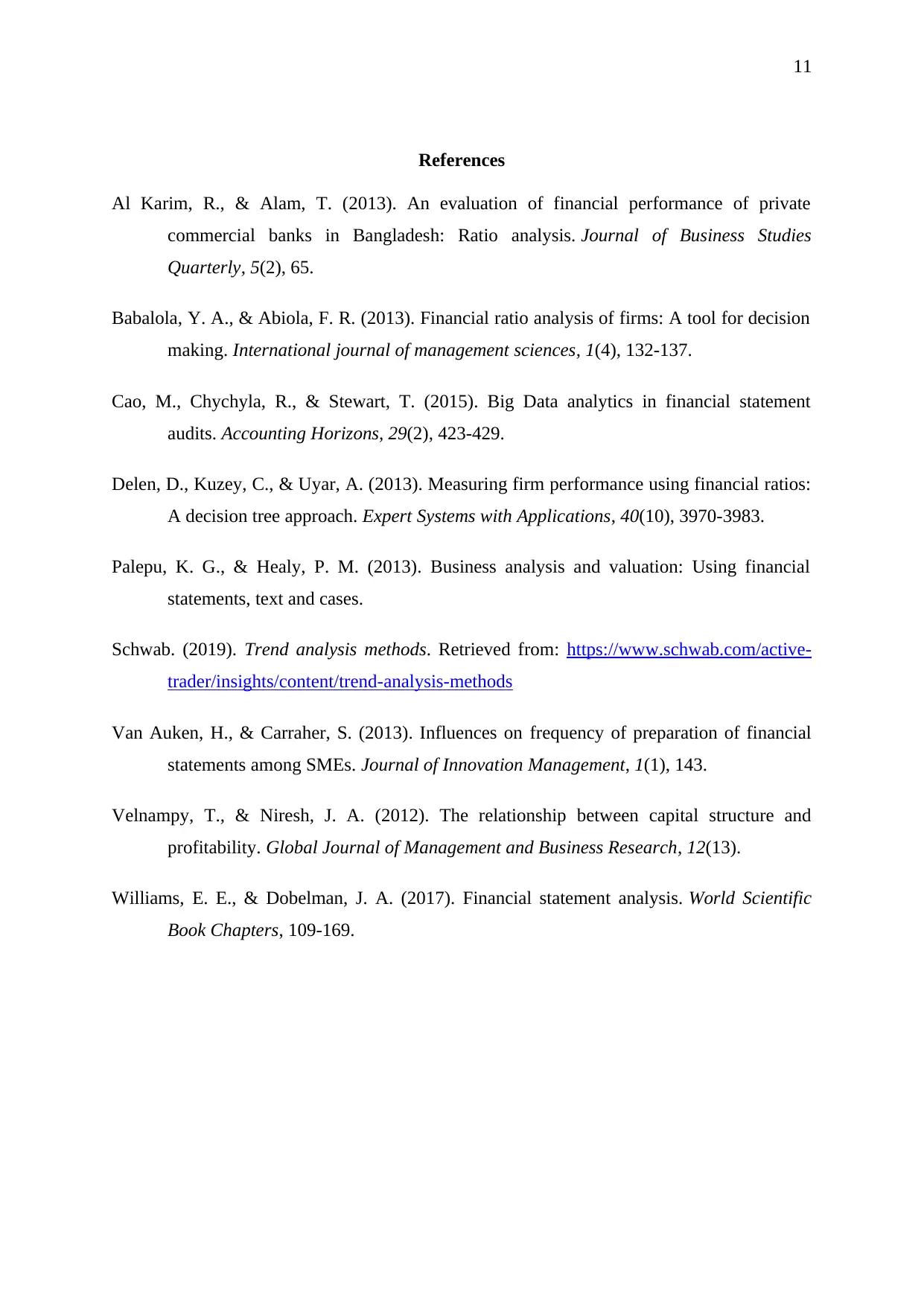
11
References
Al Karim, R., & Alam, T. (2013). An evaluation of financial performance of private
commercial banks in Bangladesh: Ratio analysis. Journal of Business Studies
Quarterly, 5(2), 65.
Babalola, Y. A., & Abiola, F. R. (2013). Financial ratio analysis of firms: A tool for decision
making. International journal of management sciences, 1(4), 132-137.
Cao, M., Chychyla, R., & Stewart, T. (2015). Big Data analytics in financial statement
audits. Accounting Horizons, 29(2), 423-429.
Delen, D., Kuzey, C., & Uyar, A. (2013). Measuring firm performance using financial ratios:
A decision tree approach. Expert Systems with Applications, 40(10), 3970-3983.
Palepu, K. G., & Healy, P. M. (2013). Business analysis and valuation: Using financial
statements, text and cases.
Schwab. (2019). Trend analysis methods. Retrieved from: https://www.schwab.com/active-
trader/insights/content/trend-analysis-methods
Van Auken, H., & Carraher, S. (2013). Influences on frequency of preparation of financial
statements among SMEs. Journal of Innovation Management, 1(1), 143.
Velnampy, T., & Niresh, J. A. (2012). The relationship between capital structure and
profitability. Global Journal of Management and Business Research, 12(13).
Williams, E. E., & Dobelman, J. A. (2017). Financial statement analysis. World Scientific
Book Chapters, 109-169.
References
Al Karim, R., & Alam, T. (2013). An evaluation of financial performance of private
commercial banks in Bangladesh: Ratio analysis. Journal of Business Studies
Quarterly, 5(2), 65.
Babalola, Y. A., & Abiola, F. R. (2013). Financial ratio analysis of firms: A tool for decision
making. International journal of management sciences, 1(4), 132-137.
Cao, M., Chychyla, R., & Stewart, T. (2015). Big Data analytics in financial statement
audits. Accounting Horizons, 29(2), 423-429.
Delen, D., Kuzey, C., & Uyar, A. (2013). Measuring firm performance using financial ratios:
A decision tree approach. Expert Systems with Applications, 40(10), 3970-3983.
Palepu, K. G., & Healy, P. M. (2013). Business analysis and valuation: Using financial
statements, text and cases.
Schwab. (2019). Trend analysis methods. Retrieved from: https://www.schwab.com/active-
trader/insights/content/trend-analysis-methods
Van Auken, H., & Carraher, S. (2013). Influences on frequency of preparation of financial
statements among SMEs. Journal of Innovation Management, 1(1), 143.
Velnampy, T., & Niresh, J. A. (2012). The relationship between capital structure and
profitability. Global Journal of Management and Business Research, 12(13).
Williams, E. E., & Dobelman, J. A. (2017). Financial statement analysis. World Scientific
Book Chapters, 109-169.

12
Appendix
Appendix
⊘ This is a preview!⊘
Do you want full access?
Subscribe today to unlock all pages.

Trusted by 1+ million students worldwide
1 out of 12
Related Documents
Your All-in-One AI-Powered Toolkit for Academic Success.
+13062052269
info@desklib.com
Available 24*7 on WhatsApp / Email
![[object Object]](/_next/static/media/star-bottom.7253800d.svg)
Unlock your academic potential
Copyright © 2020–2025 A2Z Services. All Rights Reserved. Developed and managed by ZUCOL.




